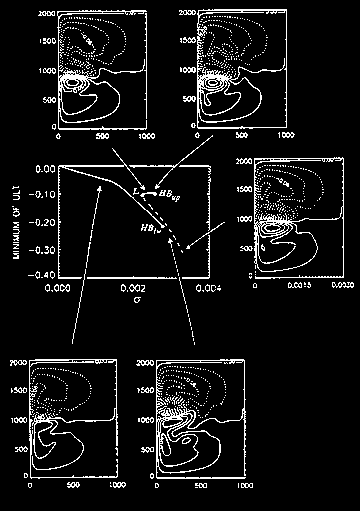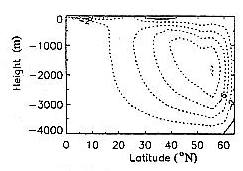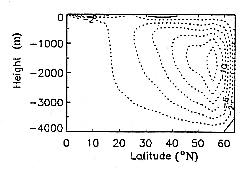 |
|||||||||
|
|
|||||||||
|
|
|||||||||
 |
|||||||||
|
|
|||||||||
|
|
|||||||||

Recent developments of observing technology, both space-borne and in situ, have greatly improved oceanic data sets, in quality as well as quantity. The study of the oceans' low-frequency variability, however, still has to rely to a large extent on models, due to the inhomogeneity and temporal shortness of the data sets; short-term predictability on synoptic time scales, on the other hand, can be studied using data assimilation.
Basin-scale oceanic motion is dominated by wind-driven (horizontal) and thermohaline (vertical) circulations. Their variability, independently and interactively, may play a significant role in climate changes, past and future. The wind-driven circulation plays a role mostly in the oceans' subannual-to-interannual variability, while the thermohaline circulation is most important in decadal-to-millenial variability. Our approach is to study the two governing circulations separately, and then in terms of their interaction, especially on the interannual-to-interdecadal time scale. Dynamical-systems methods, especially from bifurcation theory, provide a powerful tool to reveal the processes underlying the oceans' variability.
 The horizontal circulation of the mid-latitude ocean is governed by its wind-driven, double-gyre structure.
As shown in the bifurcation diagram (center) of a reduced-gravity, shallow-water model, its behavior can change, even for fixed wind stress, depending on the system's parameter values. Single and multiple equilibria, purely and quasi-periodical oscillations, and chaotically varying flow occur as the stress on the system increases or the constraints on its motion decrease. The variability has dominant peaks at subannual and interannual time scales; the exact periods of these peaks depend, in turn, on basin size. Other panels in the figure are snapshots of the model's upper-layer thickness for various parameter values (from Speich et al., 1995).
The horizontal circulation of the mid-latitude ocean is governed by its wind-driven, double-gyre structure.
As shown in the bifurcation diagram (center) of a reduced-gravity, shallow-water model, its behavior can change, even for fixed wind stress, depending on the system's parameter values. Single and multiple equilibria, purely and quasi-periodical oscillations, and chaotically varying flow occur as the stress on the system increases or the constraints on its motion decrease. The variability has dominant peaks at subannual and interannual time scales; the exact periods of these peaks depend, in turn, on basin size. Other panels in the figure are snapshots of the model's upper-layer thickness for various parameter values (from Speich et al., 1995).
 |  |
| TCD Members: | |||||||||||||||||||||||||||||||||||
| M. Ghil, K. Ide, S. Kravtsov. | |||||||||||||||||||||||||||||||||||
| References: |
|
Chen, F., and M. Ghil, 1995: Interdecadal variability of the
thermohaline circulation and high-latitude surface fluxes, J. Phys.
Oceanogr., 25, 2547-2568.
|
|
Chen, F., and M. Ghil, 1996: Interdecadal variability in a
hybrid coupled ocean-atmosphere model, J. Phys. Oceanogr., 26,
1561-1578.
|
|
Feliks, Y., and M. Ghil, 1996: Mixed barotropic-baroclinic eddies
growing on an eastward midlatitude jet. Geophys. Astrophys. Fluid
Dyn., 82, 137-171.
|
|
Feliks, Y., and M. Ghil, 1997: Stability of a front separating water masses with different stratifications. Geophys. Astrophys. Fluid Dyn., 84, 165-204.
|
|
Ghil, M., and J. McWilliams, 1994: Workshop tackles oceanic
thermohaline circulation, Eos, Trans. AGU, 75, pp. 493,
498.
|
|
Ghil, M., and N. Paldor, 1994: A model equation for nonlinear
wavelength selection and amplitude evolution of frontal waves, J.
Nonlin. Sci., 4, 471-496.
|
|
Ghil, M., A. Mullhaupt and P. Pestiaux, 1987: Deep water formation and quaternary glaciations, Climate Dyn., 2, 1-10.
|
|
Jiang, S., and M. Ghil, 1993: Dynamical properties of error
statistics in a shallow-water model, J. Phys. Oceanogr., 23,
2541-2566.
|
|
Jiang, S., and M. Ghil, 1997: Tracking nonlinear solutions with altimetric data in a shallow-water model. J. Phys. Oceanogr., 27, 72-95.
|
|
Jiang, S., F.-F. Jin, and M. Ghil, 1995: Multiple equilibria,
periodic, and aperiodic solutions in a wind-driven, double-gyre,
shallow-water model, J. Phys. Oceanogr., 25, 764-786.
|
|
Paldor, N., and M. Ghil, 1990: Finite-wavelength instabilities of a coupled density front, J. Phys. Oceanogr., 20, 114-123.
|
|
Paldor, N. and M. Ghil, 1991: Shortwave instabilities of coastal currents, Geophys. Astrophys. Fluid Dyn., 58, 225-241.
|
|
Quon, C., and M. Ghil, 1992: Multiple equilibria in thermosolutal
convection due to salt-flux boundary conditions, J. Fluid Mech.,
245, 449-483.
|
|
Quon, C., and M. Ghil, 1995: Multiple equilibria and stable
oscillations in thermosolutal convection at small aspect ratio, J.
Fluid. Mech., 291, 33-56.
|
|
Speich, S., and M. Ghil, 1994: Interannual variability of the
mid-latitude oceans: a new source of climate variability? Sistema
Terra, 3(3), 33-35.
|
|
Speich, S., H. Dijkstra, and M. Ghil, 1995: Successive bifurcations
in a shallow-water model, applied to the wind-driven ocean circulation,
Nonlin. Proc. Geophys., 2, 241-268.
|
| ||